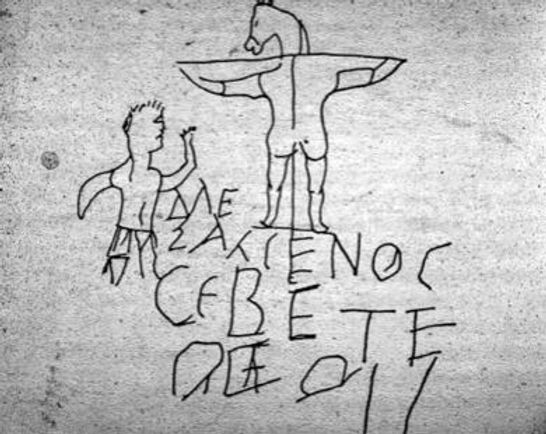The earliest surviving image of the Crucifixion appears to be an anti-Christian graffito discovered in 1857 AD, carved in plaster on a wall near the Palatine Hill in Rome, now in the Palatine Antiquarium Museum.

A Greek inscription, translated as “Alexamenos worshipping his God,” is scratched on the graffito causing it to be known as the “Alexamenos Grafitto.” (there are several variations of the translation).
The date of this graffito has been estimated as between 50-250 AD. Along with being one of the oldest surviving representations of Jesus, it may also be one of the earliest depictions of the Crucifixion of Jesus, since the event was only rarely depicted in Christian art before 6th Century AD.
The originator of the graffiti manages to mock both Jesus and Alexamenos at the same time. The so called Alexamenos graffito. It represents a satirical representation of Christian worship and it dates back to a period between 85 AD to 3rd Century AD. The drawing, scratched crudely into the soft plaster, shows a male person worshiping a figure on a cross, only the figure is wearing has the head of a donkey.
The illustration has been interpreted as Alexamenos being a Roman soldier or guard. His left hand is raised in a gesture that is suggests worship. The Greek letter upsilon or a tau cross is at the top right of the image. There has been no real consensus as to the date of the image, and estimates have ranged from 1st to 3rd Century AD.
Uppercase and lowercase Greek letter upsilon. The figure on the cross (presumed to be Jesus, although some scholars argue it could be another deity) is as we would think of a modern depiction of Christ Crucified (minus the donkey head). His arms are outstretched, pinned to the horizontal cross bar. His feet are fixed to a platform on the vertical section of the cross, and he is wearing a garment that covers the lower portion of his body.
With the Jesus figure wearing the head of a donkey, however, it is not farfetched to conclude that this illustration was meant as a mocking portrayal of a Christian performing an act of worship.
“It is assumed that the comment is sarcastic: in what appears to be an attitude of prayer, the smaller figure stands before a crucified man with the head of an ass. Contemporary Christian writers remark that pagans accuse Christians of worshiping an ass.
During the early Christian period, non-believers (who remained the majority for centuries), ridiculed Christians for worshiping a man who had been crucified – the execution method reserved for the worst criminals until it was abolished in 4th Century AD by emperor Constantine, a devout converted Christian.
At the time, it was commonly believed that Christians practiced a form of religion called onolatry, or donkey worship. This came about through misconception that Jews had worshiped a god in form of a donkey, as claimed by Apion, an Egyptian grammarian, in 1st Century BC. Tertullian, an early Christian author, also reported that Christians were accused of worshiping a donkey-headed deity.
The intentions of the author of the graffiti are, and will forever remain, unknown. Did he (or she) mean to simply mock Alexamenos and/or Jesus in relatively harmless way? Or was the purpose to “out” or intimidate Alexamenos?
“In its discussion of the graffito (under ‘Archæology of the Cross and Crucifix’), the 1908 Catholic Encyclopedia suggests that the graffiti artist may have seen actual Christian worship involving a crucifix, because the figure on the cross is wearing the perizoma, the short loincloth which is commonly used in Christian images of the crucifixion. (In actual crucifixions, the victim is naked)”
#archaeohistories






